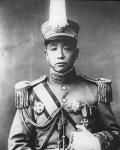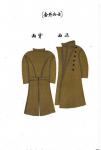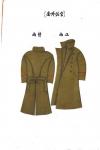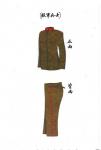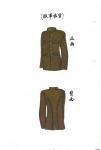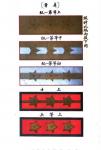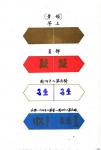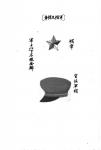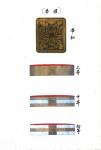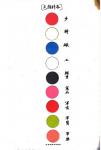-
Posts
851 -
Joined
-
Last visited
-
Days Won
3
Content Type
Profiles
Forums
Blogs
Gallery
Events
Store
Everything posted by drclaw
-
From what I gather, foreign made Warlord Orders (1912-28) are quite rare unlike the Qing Double Dragons. It seems the Republic were somewhat better organised when it came to manufacturing and distributing these. Most of the Golden Grains and the Precious Brilliant Golden Grans were locally manufactured by the Central Mint in Tianjin. I've not come across any other Chinese manufacturers of these Orders and would be interested to know if there were others. The foreign made insignia may have commissioned overseas when the Chinese Legation did not have any insignia at hand to confer on a recipient. Or it might have been privately commissioned by a foreign recipient who preferred a well known European jeweller to a Chinese manufacturer. Galerie Numismatique have a Chobillon Golden Grain at their November auction, a breast badge, 40 mm, with the makers' mark "Chobillon, Paris" on the suspension piece. It's an interestingly piece, no doubt rare, but somewhat curious in appearance. Aesthically I much prefer the Chinese insignia. http://www.coins-la-galerie-numismatique.com/decade-auction/china/order-golden-grain-1 Paul - I was interested in your comment that the Godet example was an "early type 1". The 2008 UBS Tammann catalogue refers to "first type" (1912 - ca. 1916) Golden Grains as having "finer design and enamel in cloisonne of the highest quality". The particular specimen it referred to was a Chinese piece with Chinese characters on the reverse. Unfortunately, there is no image of the characters so I don't know who the manufacturer was. If it was a Central Mint piece, than the "first type" or "second type" might refer to different manufacturing periods of the Central Mint insignia with earlier insignia being of better quality than later insignia. The Tammann "first type" specimen also has a green circular band around the centre medallion while on other specimens, this is closer to blue. Unfortunately, Warlord Order documents are even scarcer than the awards themselves so it is a real challenge to date insignia. Gavin
-

Persia - Order of the Lion and the Sun
drclaw replied to drclaw's topic in Middle East & Arab States
Hey Markus, Congratulations on discovering the maker of that "Big Head" lion. It is a charming piece and, for my money, far more characterful than the run-of-the-mill Bertrand like mine. One of the joys of our hobby is solving little mysteries like these. Well done! -
Ooops, you're quite right! I had Japanese / Manchukuo Orders in mind at the time. From what I understand, Chinese laws prohibiting the export of cultural / historical artifacts have 1911 as the cut-off date. So anything 1911 and earlier cannot be exported out of the country. It's an interesting paradox really. The vast majority of the Orders of the Double Dragons were awarded to foreigners and are therefore located overseas. Those that survived in China or which have been brought back cannot now leave the country. Most of the Warlord Orders were awarded to Chinese citizens and can be exported out of China. I'd agree with Richard though. The Warlord period was regarded with little affection by the Chinese - both at the time and later. Most of the Orders would have been destroyed during the Nationalist period, the Japanese invasions, the Civil War and the Cultural Revolution. Japan seems to be where complete sets in exquisite condition turn up - not surprising given the care the Japanese attach to old things. I wonder if many also survive in Taiwan? If you're frantically packing your gold bullion, antique jades, foreign government bonds and precious family heirlooms into your suitcase before the Communists overrun the airfield, a 30 year old Striped Tiger might not be high on your list. Unless you remember it's silver and can later be melted down ....
-
Beautiful indeed! What sort of prices do these go for now? ... assuming any even appear on the market ...
-
Sorry, I should have specified - the lapel rosette. It looks like a little rosette in a cylindar with a "foot" to affix into a buttonhole.
-
It's a Lao Tian Di specimen. Very nice. It's in great condition other than missing the rosette. A fourth or fifth class (can't remember which) sold at the recent FJP Auctions for around $3400 not taking into account sellers fee / buyers premium.
-
He died at the age of 80 of cancer in 1969. Here is his full biography taken from the World War 2 database (www.ww2db.com) Chen Shaokuan was born in Chengmen Village, Min County, Fujian Province, China in 1889. His father was originally a carpenter, but joined the Qing Dynasty Navy as a ordinary seaman, thus introducing him to the life at sea. At the age of 17, he attended the Jiangnan Naval Academy in Nanjing, China, graduating at the age of 20, and served aboard training cruiser Tongji. In 1910, he served as an ensign aboard training cruiser Jingqing. By 1914, he had already risen to the rank of lieutenant commander, serving with the headquarters of the navy of the newly formed Republic of China. In 1915, he was promoted to the rank of commander and was assigned to the vessel Zhaohe. In 1916, he visited the United States and Europe, and observed combat aboard British warships. In 1918, he served in France, Italy, and the United Kingdom as a naval attaché. From 1919, he supervised various Chinese seafaring and naval student groups in Paris, France and in London, England, United Kingdom. In 1921, he returned to China and took command of training cruiser Tongji. In 1923, he was named the commanding officer of light cruiser Yingrui. In 1926, he was promoted to the rank of rear admiral and was named the commanding officer of the 2nd Fleet. In Oct 1926, he declared allegiance to the forces aligned with the Nanjing-based government, seeing action in the subsequent months against varoius warlord factions within China during the Northern Expedition; he was named the head of the newly reorganized Navy Department, but he would fail to unify all naval forces which were operating independently under various warlords. In 1928, he submitted a request for 20,000,000 Yuan for the construction of China's first aircraft carrier; in 1930, he submitted a plan for the future expansion of the Chinese Navy, which in his vision would possess one aircraft carrier, two heavy cruisers, two light cruisers, 28 destroyers, 24 submarines, and 106 smaller vessels including gunboats, minesweepers, submarine tenders, and torpedo boats. He would never see enough funding to build such a large navy. In 1930, after several years of being second in command at the Navy Department, he returned to its leadership once again, while also being named the chief of the Jiangnan Dock & Engineering Works in Shanghai, China. In 1932, he was promoted to the rank of admiral and was inducted into the Nationalist Party Central Committee. Around this time, he reorganized the naval academy in Fujian Province, graduating many officers each year, some of whom educated by British naval officers hired to teach at the academy; he also secured funding for some of the graduates to study abroad with European navies. In 1934, he hired several Japanese naval officers to teach at the academy, which brought suspicion from some of his subordinates, as Japan had repeatedly violated Chinese sovereignty since 1931; this incidently nearly drove him to resign from his post, but ultimately he would return to office. In 1935, he was promoted to the rank of fleet admiral. In Apr 1937, he attended King George VI's coronation ceremony in the United Kingdom, followed by an inspection of the German Navy. Upon hearing the outbreak of the Second Sino-Japanese War, he rushed back to China. Chen devised a plan in which the mouth of the Yangtze River north of Shanghai would be blocked from Japanese use in an attempt to protect the capital city of Nanjing up river; the plan delayed the Japanese naval movement up river, but ultimately, as Shanghai fell, this tactic meant little; the resulting Battle of Jiangyin also saw the sinking of several Chinese cruisers, which were the main battle force of the Chinese Navy. In 1938, he was named the supreme commander of the Chinese Navy. As the coastal region fell under Japanese control, the Chinese Navy's importance decreased dramatically, and thus his influence as well; until 1946, he served as the superintendent of a private technical school as his naval duties lessened. In May 1945, he attended the United Nations conference in San Francisco, California, United States and affixed his signature on the charter document. On 9 Sep 1945, he attended the Japanese surrender ceremony at Nanjing. After WW2, the civil war between the Nationalist and Communist factions in China resumed; when ordered by Chiang Kaishek to attack communist positions in Shandong Province, Chen disobeyed, citing the the navy had not yet recovered from the war with Japan. This led to Chen being relieved of his duties. In 1949, when the Nationalist government relocated to Taiwan as defeat neared, Chiang extended the invitation for Chen to join him in Taiwan, but Chen refused, instead defecting to the newly established Communist government, serving in the Fujian Province government as well as being a member of the Central Committee. He passed away from stomach cancer in 1969
-
He'd certainly have been popular with the ladies in 1923. Later photos show him grumpier with less hair ... Chen Shaokuan (1889-1969) was born in coastal Fujian province and followed his father in joining the Qing navy. He served in the Republican navy rising to the rank of Rear Admiral when he joined the Northern Expedition. He was Admiral of the Fleet when Japan invaded China in 1937 and Chen fought a desperate rearguard action against overwhelming enemy forces. He was sacked by Chiang Kai-shek during the Civil War for refusing to attack the Communists and he joined the new Communist government.
-
Hilarious! Is it dancing? Or flying? Why is it waving a big red cape? And why does it look like something you'd find in a Beijing street market?
-
You have a very nice Fifth Class (two stars on the medal) badge. The inscription on the case reads "Wu Deng Wen Hu Xun Zhang" or Fifth Class Striped Tiger Order. Could you post an image of the maker's mark on the reverse of the badge? We will be able to tell you the maker.
-
Top right: Rear Admiral's flag Middle right: Commodore's flag Bottom right: Senior Naval Officer flag
-
Top right: National flag of the Republic of China. The five coloured bands represent the five races: red (Han Chinese), yellow (Manchu), blue (Mongolians), white (Tibetans) and black (Muslims). Middle right: Naval ensign, incorporating the Guomindang Blue Sky an White Sun on red background Bottom right: Secretary of the Navy Top left: Deputy Secretary of the Navy Middle left: Admiral's Rank Flag, incorporating the Guomindang Blue Sky and White Sun motif Bottom left: Vice Admiral
-
And now the flags! When the Republic of China was founded in 1912, groups with differing political viewpoints had different proposals for a new national flag. Eventually they were forced into making a compromise, which saw the five-striped flag becoming the national flag, the Guomindang's "Blue Sky, White Sun, Whole Field Red" flag becoming the naval ensign, and the 18-Stars Wuchang Uprising Flag becoming the War Flag. Top: The five bar, four coloured flag with the four colours representing four races of China. Later, a fifth bar (yellow) was added to represent the Manchus. Middle: The famous Wuchang Uprising flag. This became the War Flag of the Republic of China. A red flag with a black nine-pointed star and yellow disks ("War Flag") was used during the conquest of Wuhan on 10 October 1911. It was later considered a "historical" flag and was used as the war flag by the army. It was never used for civil purposes. It was designed in late September 1911 by Chen Lei and the Zhao brothers, three technical college students in Wuhan at the time. Twenty flags of this design were then made in secret by a local tailor shop owned by the Zhao family (whether this Zhao family was related to the Zhao brothers is not clear). The 18 stars represented the 18 provinces of China at the time. The Provisional Republican Government was set up on 10 October 1911 by Sun Yatsen and Li Yuanhong, a military commander in Wuchang (today is Wuchang a quarter of Wuhan). Bottom: The naval ensign. This was the Guomindang Blue Sky and White Sun against a red background flag. Sun Yatsen wanted this flag to be the national flag of the new Republic but the five coloured bar flag was selected instead representing the five races of China. When the Guomindang defeated the Beiyang government in 1928, this flag became the new national flag. (source: www.crwflags.com)
-
There has been a lot of conjecture regarding the colour of the Warlord dress uniforms. I'd always assumed them to be a very light almost grey baby blue, going from a colour tint photograph of President Yuan Shikai. But these regulation plates clearly show the blue is much darker, as also confirmed by Li Yuanhong's surviving dress uniform that Nick posted in the Grand Order / Great Merit Order (Da Xun Zhang) thread. Without my Crayola set, I'm not sure how to describe this shade. Sky blue? Interestingly, the actual height of the white egret plumes on the kepis far exceeded that in the drawings. They were obviously little men ... Here's a pic of Zhang Zuolin, the Tiger of Manchuria, who stood just five-foot-two in height ... excluding egret plume. Tomorrow I'll post the flags!
-
http://gmic.co.uk/uploads/monthly_09_2012/post-11630-0-73619200-1348914214.jpghttp://gmic.co.uk/uploads/monthly_09_2012/post-11630-0-43573000-1348914353.jpg







